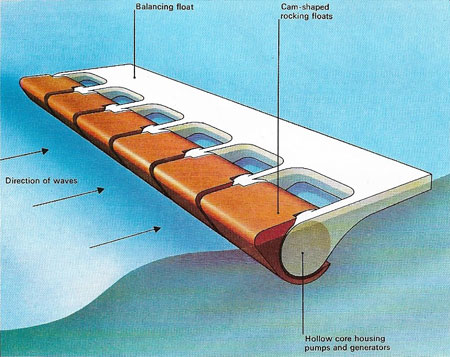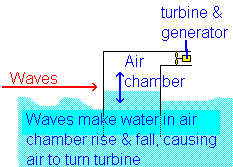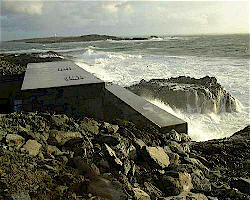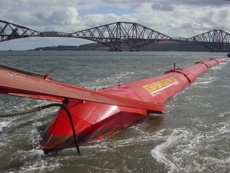wave power

Figure 1. The assembly of rocking floats shown here is designed to harness wave power and generate electricity. The structure would be about 300 meters (1,000 feet) long – the size of a supertanker. The movement of the floats works pumps and the flowing water from them powers turbines that drive electrical generators.
Water waves in the continuous swell of the open sea are a vast and as yet largely untapped source of energy. Wave power is power that comes from capturing and converting the energy available in the motion of ocean waves. When a wave passes a certain point no water moves sideways. Instead, large masses of water move up and down. This can be confirmed by watching a cork or other light object floating on a pond. When ripples pass it, it does not move along but only bobs up and down.
There are several methods of getting energy from waves, but one of the most effective works like a swimming pool wave machine in reverse. At a swimming pool, air is blown in and out of a chamber beside the pool, which makes the water outside bob up and down, causing waves. At a wave power station, the waves arriving cause the water in the chamber to rise and fall, which means that air is forced in and out of the hole in the top of the chamber. A turbine placed in this hole is will turned by the air rushing in and out, and, by connecting it to a generator, can be used to produce electricity (see Figure 2).
 |
| Figure 2. Wave power station. |
Energy derived from waves is renewable and clean. However, it is variable and needs a suitable site, where waves are consistently strong. A wave power facility must also be resilient enough to withstand rough weather.
Some wave power schemes
 |
| Figure 3. Limpet wave power generator
|
 |
| Figure 4. Pelamis wave power generator
|
Limpet (Land Installed Marine Powered Energy Transformer) is a shoreline energy converter sited on the island of Islay, off Scotland's west coast (see Figure 3). The current Limpet device, called Limpet 500, was installed in 2000 and produces power for the UK national grid. It uses the principle of an oscillating water column described above, and has been optimized for annual average wave intensities of between 15 and 25 kW/m. The water column feeds a pair of counter-rotating turbines, each of which drives a 250kW generator, giving a nameplate rating of 500kW. The company behind Limpet, Wavegen, is developing the technology used in Limpet to build a series of commercial power generators.
Another Scottish company, Ocean Power Delivery, is developing a method of offshore wave energy collection that uses a floating tube called the Pelamis (see Figure 4). This long, hinged tube (about the size of 5 railway carriages) bobs up and down in the waves. As the hinges bend they pump hydraulic fluid which drives generators. The Pelamis has an output similar to a modern wind turbine.
